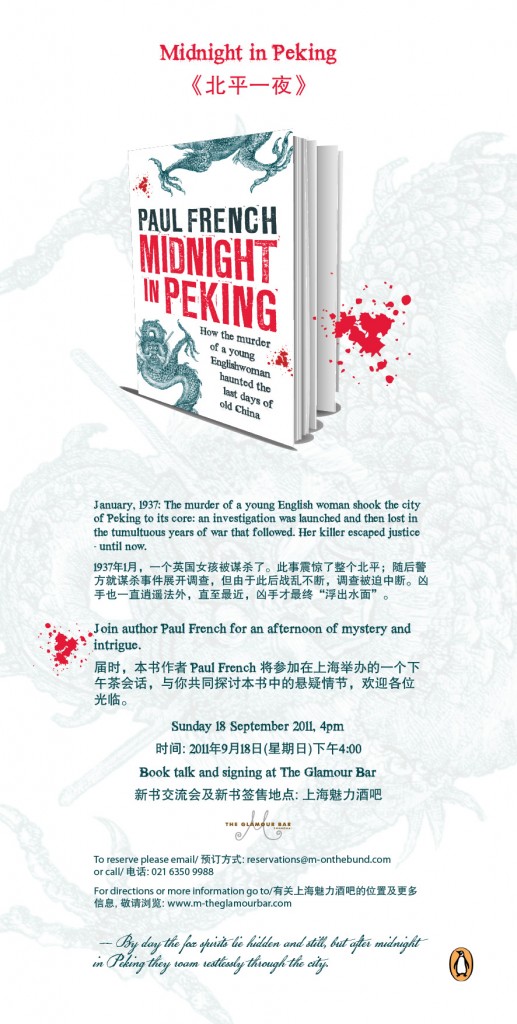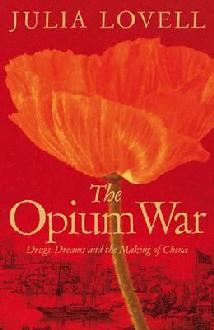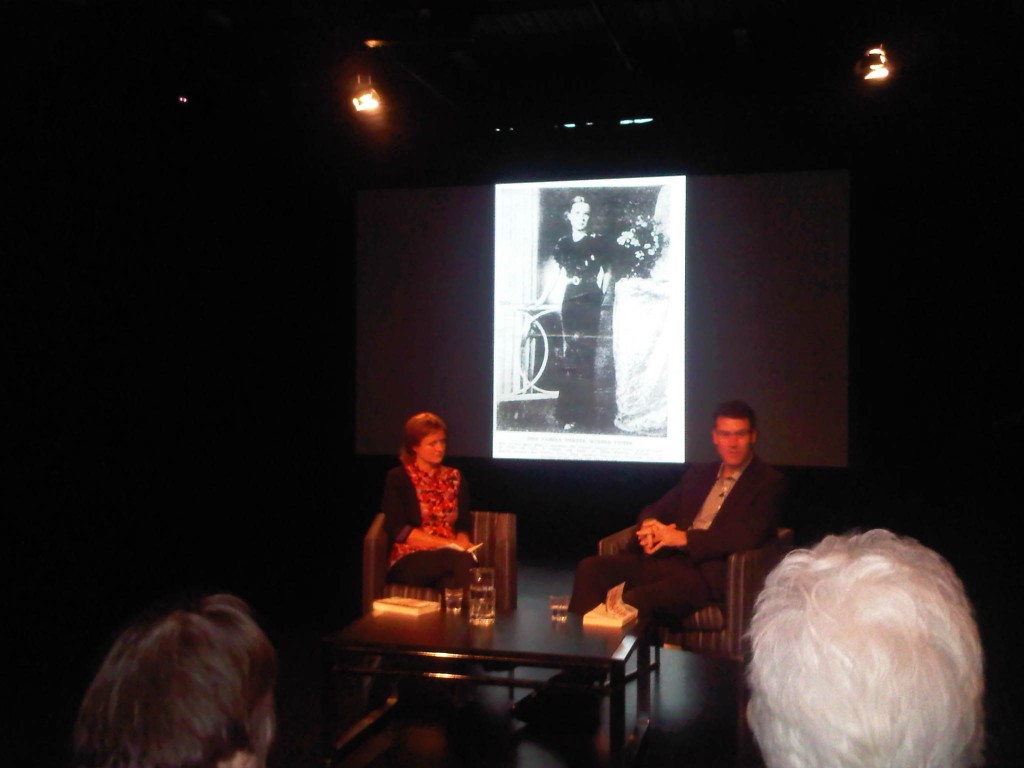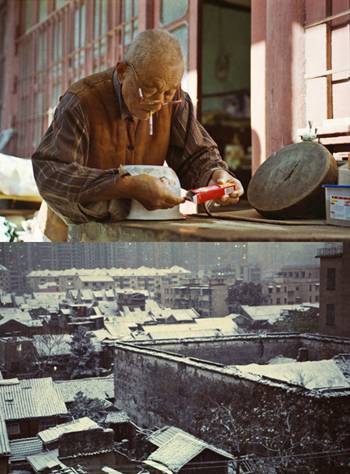Posted: September 15th, 2011 | 2 Comments »
Back home for a few days and so it’s time to launch Midnight in Peking in Shanghai to the home crowd (actually the launch in Peking last night was pretty, and I don’t use this word often, awesome with a crowd of modern day ex-pat Peking ne’erdowells in attendance wonderfully). And so it’s back to the lovely Glamour Bar at M on the Bund once more – a venue that’s never been anything but very generous and charitable to me over the years.
We’ll be delving into the Badlands, the old Legation Quarter, the white mischief and the scandal from 4pm

Posted: September 15th, 2011 | No Comments »
Good to see that the old Yellow Peril characters live on down under and that Charlie Chan, ace Chinese detective and creation of Earl Derr Biggers remains well known. Of course this pub and pokie machines parlour close to Sydney’s Chinatown could just be owned by a bloke called Charlie Chan, but I somehow doubt it. And as it’s been a while since we’ve had a modern day opium den post (there have been others in the past such as here and loads here too) so it seemed time to post another old Yellow Peril follow on.


Posted: September 14th, 2011 | No Comments »
Julia Lovell is talking about her new book, The Opium War, at London’s Asia House on September 15th. Should be well worth listening to and attending to details as below. There was a good Q&A with Julia in Time Out Hong Kong recently also worth reading.
Julia Lovell- The Opium War:
Drugs, Dreams and the Making of China
Thursday 15 Sep, 2011 6:45 PM
Beginning with the drama of the war itself, Julia Lovell explores its causes and consequences, and through this larger narrative, interweaves the curious stories of opium’s promoters and attackers. The Opium War is both the story of modern China—starting from its first encounter with the West—and an analysis of the country’s contemporary self-image. It explores how China’s national myths mould its interaction with the outside world, how public memory is spun to suit the present, and how delusion and prejudice have bedevilled its relationship with the modern West.
Julia Lovell teaches modern Chinese history at Birckbeck College, University of London. She is the author of The Great Wall: China Against the World and The Politics of Cultural Capital: China’s Search for a Nobel Prize in Literature. She writes for the Guardian, Independent and The Times Literary Supplement.
You can read the excellent Isabel Hilton’s review of Julia’s book in The Guardian here
£10/£8 concessions
Asia House Friends : £6
You can book via the website here

Posted: September 13th, 2011 | No Comments »
A quick bit of self-promotion – a good review from the hometown rag That’s Shanghai here.
And how satisfying it was at the Melbourne Writers Festival at the weekend to bring Pamela back to the public’s attention and see her picture on the screen.

Posted: September 12th, 2011 | No Comments »
You can learn a lot if you spend a few weeks down under. Like, did you know that the eponymous Aussie Dingoe originally got to Oz from China? I didn’t….but I must admit I’d never really spent any serious time pondering the origins of the Dingoe. It’s an imprecise science too – according to Aussie scientists Dingoes arrived some time between 4,600 and 18,300 years ago; a pretty wide spread to choose from there! It seems that some dingoes came straight to Australia while others took a more leisurely route via PNG and Polynesia.
This could all get horribly political too. The previous theory was that Dingoes had come to Australia from either the Philippines or, wait for it, Taiwan!! Now it seems the Taiwan theory is blown out of the water and Dingoes are mainlanders!!
Here’s the whole story from The Australian paper.

Posted: September 12th, 2011 | No Comments »
The Royal Asiatic Society in Shanghai has what looks to be a very interesting event this Tuesday (13th). Sorry I didn’t post earlier on this but travel down under and book events means I’m a bit behind. Anyway….Katya Knyazeva is a journalist and photographer based in Shanghai and her work around the juxtapositions of the old town of Shanghai, heritage, preservation and the bulldoze all, wreck all mentality of the local planners is one of THE major issues for Shanghai as it develops.
RAS LECTURE
Tuesday 13th September, 2011 at 7:00 p.m.
Tavern, Radisson Plaza Xingguo Hotel 78 Xing Guo Road,Shanghai
兴国宾馆 上海市兴国路78å·
Katya Knyazeva
Shanghai Old Town: Topography of a Phantom City

The Chinese City is a compact low-rise slum downtown. It is poor and very small, occupying 0.03% of metropolitan Shanghai. Most lanes are too narrow for cars and much of the housing stock is overcrowded and dilapidated. It’s an embarrassment for locals and a little baffling for visitors. But for seven hundred years this was all of Shanghai, a prestigious merchant city, a colony of leisure gardens and a multicultural hub. Long before the era of the concessions, Shanghai was a magnet for sea merchants, agribusiness and gentry from all eastern China.
The opening of the treaty port in 1843 revolutionized Shanghai. As the urban core moved north and inland, the old city became insignificant. The surrounding wall and separate status alienated it from the rising colonial metropolis, and this segregation led to its economic decline.
But cohesion and isolation preserved the old town. Artifacts and architectural styles from two dynasties are still embedded in the fabric of the alleys. Despite the march of calamities in the last century, one can still find living remnants from every facet of Shanghai’s long history, from the Revolution to Qing ruins to thousand-year-old streets.
Today, as the antique lanes are steadily liquidated, the question of city identity brings us back to a ‘Shanghai’ that’s far older than the French Concession or the Bund. The old town is a cluster of organic, pedestrian-friendly neighborhoods that developers are keen to demolish and historians are struggling to preserve. The old city is authentically mixed-use and polymorphous: generations of residents, artisans, tiny businesses and antiquities are enfolded within the membrane of its lanes.
The old town’s rustic character is unique for being so central, but its location is hazardous. The government has a financial stake in evicting the poor and integrating the old town into the traffic flow of the surrounding city. Success for the planners will be the death of the old town. But for the present, old Shanghai is an urban zone unlike any in China, vibrant yet clandestine, a living intersection of eras.
Katya Knyazeva is a journalist and photographer born in Siberia. After two years as interpreter and event coordinator in Russia’s largest ballet theater, she moved to South Korea to pursue a master’s degree in design. This led to working as a fine arts book illustrator in Seoul, the United States and then Shanghai, where an interest in transitional neighborhoods led Katya into urban studies and photojournalism. Since moving to China in 2006 she has published articles on Chinese cuisine, theater, fine arts and history.
For the last two years Katya has been working on a photographic atlas of Shanghai’s old town. This book is a comprehensive street guide and oral history of the oldest and most obscure quarter in Shanghai.
Entrance: RMB 30.00 (RAS members) and RMB 80.00 (non-members) those unable to make the donation but wishing to attend may contact us for exemption, prior to the RAS Lecture. Membership applications and membership renewals will be available at these events.
RSVP: to RAS Bookings at: bookings@royalasiaticsociety.org.cn
Posted: September 12th, 2011 | No Comments »
I’ll be at the always most welcoming and great Beijing Bookworm on Wednesday night talking about Midnight in Peking so if you’re around in the capital and want all the gossip on what bad foreigners used to get up to in town then come along.
14th September – 7.30pm – 20/30RMB

Posted: September 11th, 2011 | No Comments »
Time has a nice slide show of images of Singapore old and new – including a fascinating shot of an opium packing plant in 1941. Many of the older pictures were taken by the American Carl Mydans, known as Stump due to his short stature, who took great photographs in Chungking during the war before being interned in Chapei camp. Anyway, worth a few minutes browsing – click here.







